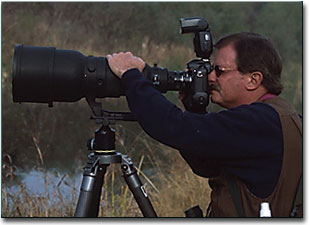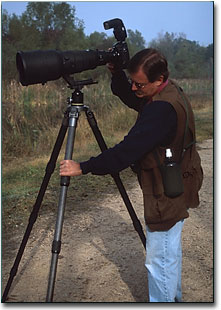
"Nice lens you have there." I looked up from my F5 viewfinder and turned to my left toward the voice. The middle-aged, fit looking gentleman smiled, raising his F5 showing me the 300mm F2.8 lens attached to it. I am used to getting a lot of comments on my equipment. A 600mm F4 is ominous, and it draws attention. The numerous questions and comments usually do not bother me, and wanting to be a good ambassador for nature photography, I always answer in a courteous fashion. His next statement perplexed me, however. "I used to have a 600mm, but I never got any good images with it. I sold it after owning it only one month" he said in a sad tone, smile faded to frown. "You have a lighter load now," I retorted, "and your 300/2.8 is one razor sharp lens." He smiled again, nodded and disappeared over the hill, tripod in tow.
I have wondered many times since that chance encounter, how many other photographers have experienced a similar fate? They save up for years, and after finally acquiring the lens they have dreamed of for a decade - that very same lens becomes their nemesis. I have known one or two who became so frustrated and disenchanted, they gave up photography altogether. Why is this so? Is the 600mm so difficult to master that only a few "gifted" photographers can rise to the challenge? Before purchasing mine, I read several horror stories of others' experiences. It seemed the behemoth lens could break the spirit of both the inexperienced and seasoned veterans alike. I was determined to conquer the learning curve, no matter how steep - I had to master it, that was my challenge! And a formidable challenge it was, but one virtually any photographer can conquer with patience, practice, and proper technique.
The chief gremlin that ruins most our images with normal to mid-range telephoto lenses is camera shake. A solid brace or better yet, a tripod, usually sends the gremlin packing. With big glass, the same gremlin is harder to dissuade. Why? Magnification is 12X with a 600mm. Anything less than a rock steady tripod and snug-to-tight ball-head tension will cause blurred images. Most photographers with big glass master tripod/ball-head technique in time, yet they still get soft images. The reason? Lens vibration. The vibration is caused by mirror flop, and it traverses the length of the lens during the time of exposure. This gremlin is unique to big glass and must be eliminated. By simply resting your free hand on the top of the lens, the vibration is absorbed before it causes any problem. No downward pressure is required; just rest the hand as if it were in your lap. To further reduce the chance of vibration, place your face firmly against the back of your camera. Again, no hard pressure is necessary, just firm and steady.

It is easy to get rushed when setting up, especially when you are trying to hurry before that gorgeous Great Egret in breeding plumage flies off. Last winter I was working with a group of aspiring young photographers at one of our local water sheds. One lad was in such a hurry to photograph the waterfowl, he failed to tighten the plate holding his F100/400mm. He turned to get film and his rig fell five feet onto asphalt. Not a pretty sight. Take the time to tighten all knobs, and test the tripod for rigidity before you mount the big lens. With one hand on the camera to keep it steady, using moderate pressure, push downward with your other hand on each leg to ensure everything is tight (inset photo). Re-check tension several times if you are out all day, as knobs can work loose in the field.
Ideally we want to work with the tripod level with the world. It is a fairly simple matter to adjust height on one or two legs, if you have time. It's best to adjust the lower, less rigid legs. Just be careful not tip the rig in the process. I have found that with fast moving subjects such as birds and other wildlife, there simply is not time to adjust tripod legs in the field. You can still create sharp images with a slightly non-level tripod by using proper lens technique.
Granted, big glass is not for everyone. Not only do they cost what you would expect to pay for a good used car, but they are heavy and bulky as well. Forget hiking five miles with one. But if you want the ultimate experience for birds and long distance image making, big glass fills the bill better than anything. Don't believe those horror stories - you CAN learn to use big glass with a modicum of patience, practice, and proper technique.
BH-NPN

